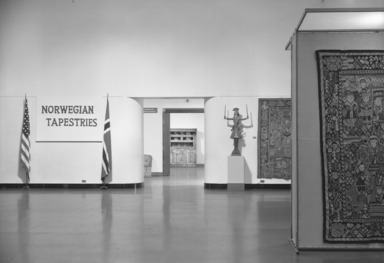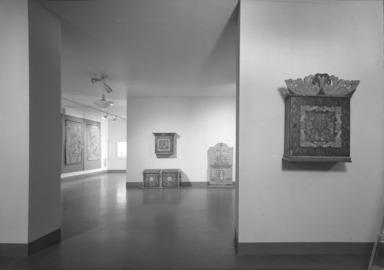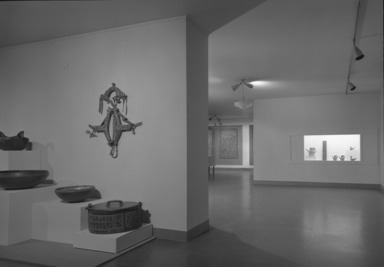

Norwegian Tapestries, September 22, 1959 through October 25, 1959 (Image: CTX_E1959i001.jpg Brooklyn Museum photograph, 1959)

Norwegian Tapestries, September 22, 1959 through October 25, 1959 (Image: PHO_E1959i018.jpg Brooklyn Museum photograph, 1959)

Norwegian Tapestries, September 22, 1959 through October 25, 1959 (Image: PHO_E1959i019.jpg Brooklyn Museum photograph, 1959)

Norwegian Tapestries, September 22, 1959 through October 25, 1959 (Image: PHO_E1959i020.jpg Brooklyn Museum photograph, 1959)

Norwegian Tapestries, September 22, 1959 through October 25, 1959 (Image: PHO_E1959i021.jpg Brooklyn Museum photograph, 1959)

Norwegian Tapestries, September 22, 1959 through October 25, 1959 (Image: PHO_E1959i022.jpg Brooklyn Museum photograph, 1959)

Norwegian Tapestries, September 22, 1959 through October 25, 1959 (Image: PHO_E1959i023.jpg Brooklyn Museum photograph, 1959)

Norwegian Tapestries, September 22, 1959 through October 25, 1959 (Image: PHO_E1959i024.jpg Brooklyn Museum photograph, 1959)
Norwegian Tapestries
-
September 8, 1959
For the first time in America, an exhibition of more than a hundred rare, centuries-old Norwegian tapestries and carved furniture and wood work will be shown at the Brooklyn Museum beginning September 22 through October 25.
Over four years in the planning, this major exhibition is one of the most important collections of Norse folk art ever presented in this country. It was organized by the Smithsonian Institution in cooperation with the Norwegian Government, under the patronage of His Majesty King Olav V. Every museum and many private collections in Norway are represented in this outstanding presentation of forty story-telling tapestries and the many wood carvings dating from the 16th, 17th and 18th centuries.
Marvin D. Schwartz, Curator of the Brooklyn Museum’s Decorative Arts Department states, “The tapestries reveal a pictorial language which is unique. In this unusual style, three dimensional scenes are translated into delightfully flat patterns, particularly important to modern designers who are once again turnIng to the past for inspiration.”
The scenes woven with veg[e]table-dyed homespun wools, range from the coat of arms of King Christian IV, through the mythological themes of the Rape of the Sabine Women and the Medusa Head to the Biblical stories of Lot and His Daughters, The Magi and the AdoratIon, The Feast of Herod, and the amusing representation of the Five Wise and Five Foolish Virgins.
The mid-17th century tapestry of the Virgin ladies, woven in red, green, blue [and] yellow, portrays the Wise Virgins holding candles as they stand with the Celestial Bridegroom. In the lower half of this famed tapestry the Foolish Virgins are seen weeping with handkerchiefs in their hands, standing with a figure known as the “Merchant of Eros.”
From the late 17th century and in the Renaissance tradition of the 1600’s, one of the tapestries depicts the story of Lot and His Daughters and the Flight from Sodom with a wide border of flowers and fruit in blue, green, pink, yellowish-beige and brown. The figures draped in flowing robes are in the delightful and peculiar linear patterns. “Here, as in all the tapestries,” Mr. Schwartz observes, “is an example of folk art where the medium is exploited by making the most of the rough texture of the wool. Although the picture of Lot and His Daughters closely relates to High Style in the 1600’s, they are rendered in a technique based on an age-old tradition.”
This tradition became especially important to the people of Norway after the Black Plague of 1349-50 which swept Europe leaving an inert society and a stagnant artistic and cultural life. During the three centuries which followed the Plague, it lost its political autonomy, its Royal court, its wealthy burgers and all incentive toward literary and artistic endeavors. It was during this period when the best creations in the fields of decorative handicrafts were done that most of the work in this exhibition dates. Norwegian peasants preserved their individual freedom more than most peasants in Europe and produced a folk art which was individual, free and decorative.
In a statement describing the history and tradition of the art, Dr. Thor B. Kielland, Director of the Folk Museum in Oslo, concludes, “the golden age of Norwegian tapestry weaving shows in essence the best ingredients of the North European Renaissance blended with old native traditions in which a firm decor and a predilection for strong bright color can be traced right back to the Viking Age.”
In the early sagas it is recorded that Saint Olav’s mother, Queen Asa, ordered “four women to decorate the hall with tapestries and woven bench covers” in honor of her son’s visit. The same procedure was followed in 1589 at the marriage of James I of England. As recently as 1947 this old custom was revived for the celebration of King Hakin’s 75th birthday when tapestries were borrowed from private collections as well as from museums.
As in the tapestries, the representations on the furniture and other woodwork are bold and schematic but with the figures rendered with more curves which is possible through the groove method of carving. Most of the wooden objects are made of Norwegian pine or birch which often was originally painted in familiar colors. Biblical scenes, animals, geometrical and architectural designs and the acanthus leaf are favorite motifs.
Included in the wide variety of wood work in the exhibition is a hanging pine cupboard dated 1758. Only 36 x 34 inches, the cupboard is richly carved with scenes that include Abraham’s Sacrifice, the four Evangelists, Elijah’s Ascension, the Last Supper, Moses with the Tablets of Law, Jacob's Dream, and the Apocalypse, angels, lions, Jacob’s Fight with the Angel and Elijah in the desert. This elaborate work is painted in red, green, blue-green, ocher and yellow on a white background.
A quaint mixture of the religious and profane appears in a Powder Horn, signed 1697 and loaned by the Norwegian Folk Museum in Oslo. Here, in nine and one half Inches, are carved figures of Adam and Eve, Samson and Delilah, Diderik of Bern, the Lion and the Worm-Dragon, the Count, Gonslin, and Ivan Bla, and Burmann (the Pagan King).
Some of the most appealing of the 55 wood carvings on display at the Brooklyn Museum are the lusty drinking vessels. Dippers, tankards, goblets, beer bowls - with or without spout - are made in the shape of birds, hens, geese, ducks, cocks, ram’s heads., etc. usually of birch. Generally carved in low relief, some are painted in primary colors with traditional designs of fruit, vines, leaves and animals. Those In the exhibition date from 1700 to the mid 19th century. One of the most interesting is a bowl in the shape of a hen painted green with a spout in its chest. Bowls with spouts, called trøys, were used to pour beer into smaller cups and were extremely popular. Another unusual beer bowl, dated 1751, called a Kjenge, is made of Norwegian pine, painted black, has two handles in the shape of horses’ heads and is characteristic of Western Norway. The oldest wood carving in the exhibition is a six inch cup, dated 1700, made of birch and carved in low relief. Carved and painted benches, cupboards, mangle boards, hanging cupboards, door panels and tankards are also seen in this outstanding display of folk art.
Other cities in the U.S. will see the exhibition following the five week showing at the Brooklyn Museum where it is sponsored by the Bay Ridge Savings Bank.
Brooklyn Museum Archives. Records of the Department of Public Information. Press releases, 1953 - 1970. 1959, 031-34.
View Original -
September 17, 1959
On the night of September 21st, the Brooklyn Museum opens its first major exhibition of the season with an invitational preview of the most important collection of Norwegian Folk Art ever shown in the United States. This rare exhibition of more than one hundred 16th, 17th and 18th century tapestries and woodcarvings is presented under the official auspices of President Dwight D. Eisenhower and His Majesty, King Olav V.
Preceding the opening, a number of private dinner parties are being given for the many invited guests from Norway, Washington and the Norwegian-American community of Brooklyn. Mr. John A. Westergaard, an importer and one of the leading experts on Scandinavian foods in this country, has arranged a special smorgasbord buffet for forty well-known designers of fabric and furniture and magazine editors. Mrs. Dorothy Liebes, one of America’s leading textile designers, is the hostess for this special event.
As a major contributor to the event, Mr. Westergaard stated, “It is a great pleasure for me to be able to participate in this undertaking. I am anxious to do all I can to bring the Norwegian Folk Art exhibition to the attention of designers in this country. The folklore and art of Norway is not very well known here and perhaps this important exhibition at the Brooklyn Museum will stimulate new design ideas.”
In addition to his many other civic Interests, Mr. Westergaard is past-president of the New York State Inter-Collegiate Ski Association, is a member of the Explorers' Club and a graduate of Colgate University.
Brooklyn Museum Archives. Records of the Department of Public Information. Press releases, 1953 - 1970. 1959, 070-071
View Original -
September 11, 1959
Bay Ridge Savings Bank sponsors Exhibition
On the night of September 21, the Brooklyn Museum will open its first major exhibition of the season with a special invitational opening for more than 1600 members of the Museum and hundreds of Norwegian-American community leaders and state officials.
The evening spotlights the first showing of the most important collection of Norwegian folk art ever shown in America, featuring more than one hundred 16th, 17th and l8th-century tapestries and woodcarvings. This rare exhibition is presented under the official auspices of President Dwight D. Eisenhower and His Majesty, King Olav V. It was arranged by the Smithsonian Institution in cooperation with the government of Norway, and is being sponsored in Brooklyn by the Bay Ridge Savings Bank in celebration of the bank’s 50th anniversary.
Guests at the opening will be introduced to His Excellency, Paul Koht, the Norwegian Ambassador, followed by many other highlights arranged by the Museum for this special occasion, including a lavish smorgasbord of the finest imported Norwegian delicacies contributed by The President of the Norwegian Chamber of Commerce, Mr. Sevrin A. Haram. The distinguished Brooklyn citizen’s contribution will be served in traditional style with refreshments shipped especially from Oslo to Brooklyn for the occasion through the courtesy of Frydenlund Brewery and A/s Vinmonopolet. The native beer and aquavit will be served from whole blocks of ice in the Norwegian manner.
Members of the Norwegian-American community of Brooklyn will be on hand in native costume to add to the pageantry of the evening and to create a background of folk music. The evening will begin formally with a short greeting from His Excellency, Mr. Paul Koht, the Norwegian Ambassador. Mr. Koht will bring greetings from His Majesty, King Olav V of Norway. A short motion picture, recently completed in Norway, will be flown here by arrangement with the distributor, Encyclopedia Britannica Films, Inc. The preview is for the invited guests who will be asked for their comments.
Hostesses for the evening, from the Museum’s Community Committee, will be headed by Mrs. Samuel Berke of the Flatbush area and her assistants Mrs. M. Theodore Tanenhaus and Mrs. Robert T. H. Davidson.
DINNER PARTIES SET FESTIVE PACE FOR OPENING AT BROOKLYN MUSEUM
Preceding the opening at the Museum a number of private dinner parties will be given for the distinguished guests. Among the guests to be entertained by Mr. and Mrs. Robert E. Blum are His Excellency the Norwegian Ambassador Mr. Paul Koht and Mrs. Koht and Mr. and Mrs. David B. McVeen, President of the Bay Ridge Savings Bank sponsor of the Brooklyn Museum exhibition.
Mr. and Mrs. Harry Schoenfeld, Mrs. Florence Zirinsky Friedman, Mr. and Mrs. John R.H. Blum and Dr. and Mrs. Leo J. Swirsky are also giving dinners with guest lists including Mr. and Mrs. Sivert Nielsen, Norwegian Ambassador to the U.N., Mr. and Mrs. Knut Thommessen, Norwegian Consul General, Mr. and Mrs. S.A. Haram, President of the Norwegian Chamber of Commerce, Mr. and Mrs. Carl Soyland, Editor of Nordisk Tidende, Mr. and Mrs. Raymond Donnett, President of the Norwegian-American Foundation and many other important Norwegian and Norwegian-Americans.
A special smorgasbord is being provided by Mr. John Westergaard for the dinner given by Mrs. Dorothy Liebes for well-known designers of fabric and furniture as well as editors of national magazines. The dinner parties will be held at an early hour so that guests will arrive at the Brooklyn Museum for the 9 o’clock opening.
Brooklyn Museum Archives. Records of the Department of Public Information. Press releases, 1953 - 1970. 1959, 072-074
View Original -
October 6, 1959
The first of a series of illustrated lectures at the Brooklyn Museum will be held in the Third Floor Auditorium at 3:45 on Sunday, Oct. 18.
Dr. Thorvald Krohn-Hansen, responsible for the assembling of the outstanding collection of Norwegian tapestries and woodcarvings currently on exhibition at the Museum, will illustrate his Norwegian Folk Art lecture with color slides from the Norse country.
Dr. Krohn-Hansen, author of several important books on Norwegian folk art, is the Director of the Northern Museum of Applied Arts in Trondheim and a member of the Royal Norwegian Scientific Society. He is also a Board member of the National Association of Norwegian Museums and the Scand[i]navian Society of Museums.
He accepted the speaking engagement at the Museum, stating, “I am very pleased to be asked to speak to the people of Brooklyn. They have been so enthusiastic about the Norwegian tapestry exhibition, and I look forward to meeting with the Museum’s interested audience.” For the lecture series, the Museum audience referred to by Dr. Krohn-Hansen is the adult public which is invited to attend this admission free event.
Other free of charge lectures include a fascinating discussion of DISASTERS IN COLLECTING EGYPTIAN ART by John D. Cooney on Sunday, Oct. 25 and, on the following Sunday, Nov. 1, the award-winning artist, Gabor Peterdi will describe the EVOLUTION OF 20th-CENTURY PRINT MAKING.
Brooklyn Museum Archives. Records of the Department of Public Information. Press releases, 1953 - 1970. 1959, 044.
View Original -
September 10, 1959
A leading Brooklyn citizen, Mr. Sevrin A. Haram, will share honors with the Ambassador of Norway at the invitational opening of the Distinguished Norwegian Folk Art Exhibition on the night of September 21 at the Brooklyn Museum.
A record attendance of Museum Members and their guests from the Norwegian-American community is expected for the unveiling of this major exhibition, arranged by the Smithsonian Institution and sponsored by the Bay Ridge Savings Bank, consisting of more than one hundred 16th, 17th and l8th-century woodcarvings. Among the many highlights arranged for the opening, will be the official presentation by the Norwegian Ambassador, His Excellency, Paul Koht, followed by the lighting of the candle over the large, festive smorgasbord contributed by S.A. Haram, President of the Norwegian Chamber of Commerce, and a specialist in the import of Norwegian food products.
In making this contribution of the foods and decorations for the gala opening, Mr. Haram stated, “the showing of the distinguished folk arts of Norway at the Brooklyn Museum will do much to contribute to the further unity of the people of America and Norway. I am happy to be able to make my contribution to this worthy event.”
Mr. Haram, head of his own firm of Norwegian food products, has been among the personalities who have influenced the Norwegian-American scene. On May 17 of this year he was honored by the King of Norway when he was named a Commander in the Royal Order of St. Olav of Norway in recognition of his lifelong work to promote Norwegian interests in America and strengthen the relations between the United States and Norway.
Following the special opening, at which Mr. Haram will be one of the noted guests, the exhibition will be on view to the public through October 25 at the Brooklyn Museum, before traveling to other cities throughout the United States.
Brooklyn Museum Archives. Records of the Department of Public Information. Press releases, 1953 - 1970. 1959, 075-076
View Original

